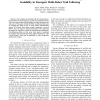Free Online Productivity Tools
i2Speak
i2Symbol
i2OCR
iTex2Img
iWeb2Print
iWeb2Shot
i2Type
iPdf2Split
iPdf2Merge
i2Bopomofo
i2Arabic
i2Style
i2Image
i2PDF
iLatex2Rtf
Sci2ools
ICRA
2010
IEEE
2010
IEEE
Blinkered LOST: Restricting sensor field of view can improve scalability in emergent multi-robot trail following
Abstract— We consider the classical task of transporting resources from source to home by a group of autonomous robots. The robots use ant-like trail following to navigate between home and source. This paper studies the effect on global performance of changing the field of view of each robot’s trail-following sensor. It is shown that, under certain conditions, a narrow field of view can improve system performance. We argue that the benefit is obtained by selectively degrading the individuals’ trail-following ability so that more work space is exploited in parallel, thus decreasing mutual spatial interference. This “worse-is-better” idea may be applicable to other large-scale multi-robot systems.
| Added | 26 Jan 2011 |
| Updated | 26 Jan 2011 |
| Type | Journal |
| Year | 2010 |
| Where | ICRA |
| Authors | S. Abbas Sadat, Richard T. Vaughan |
Comments (0)

